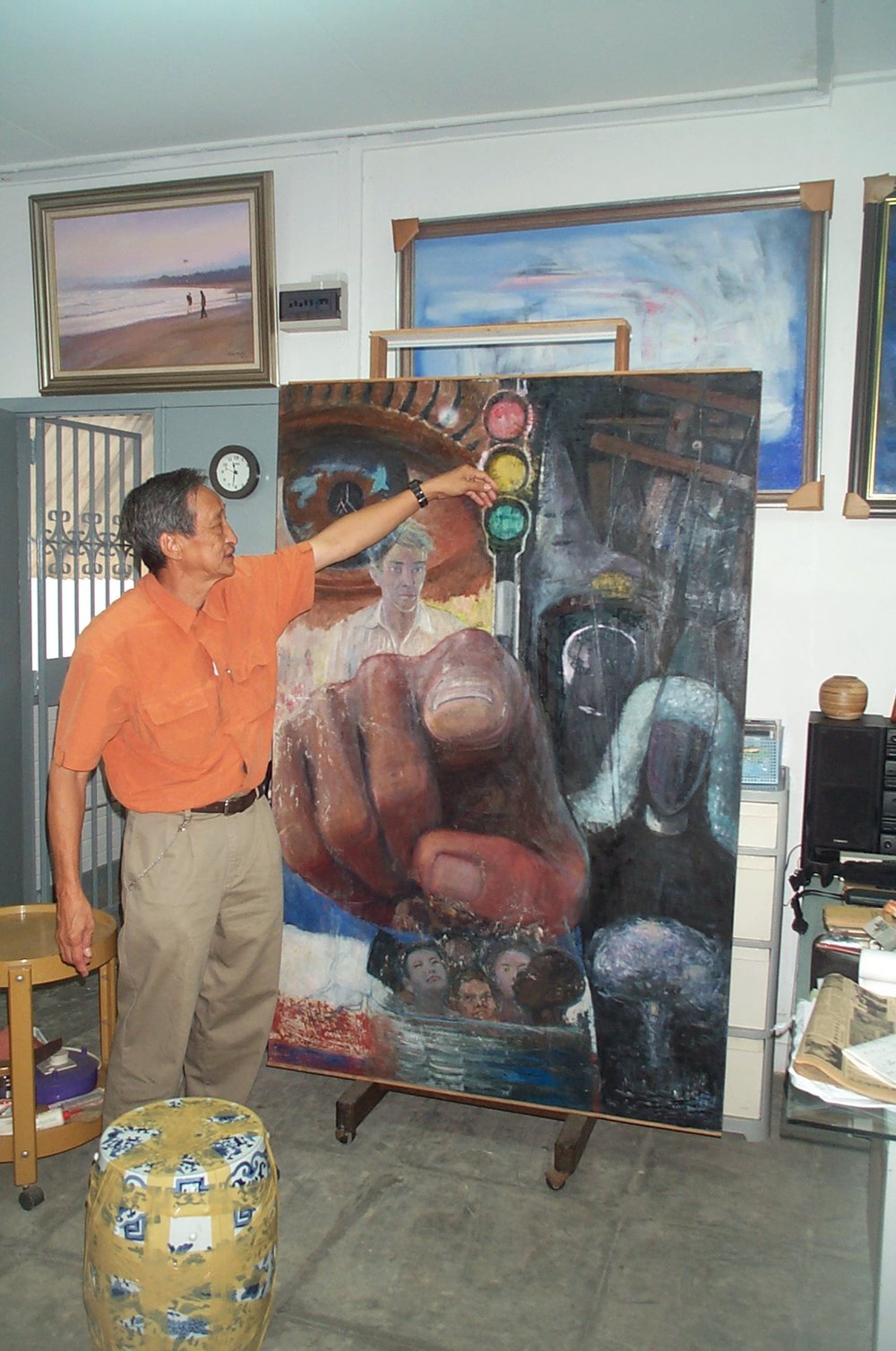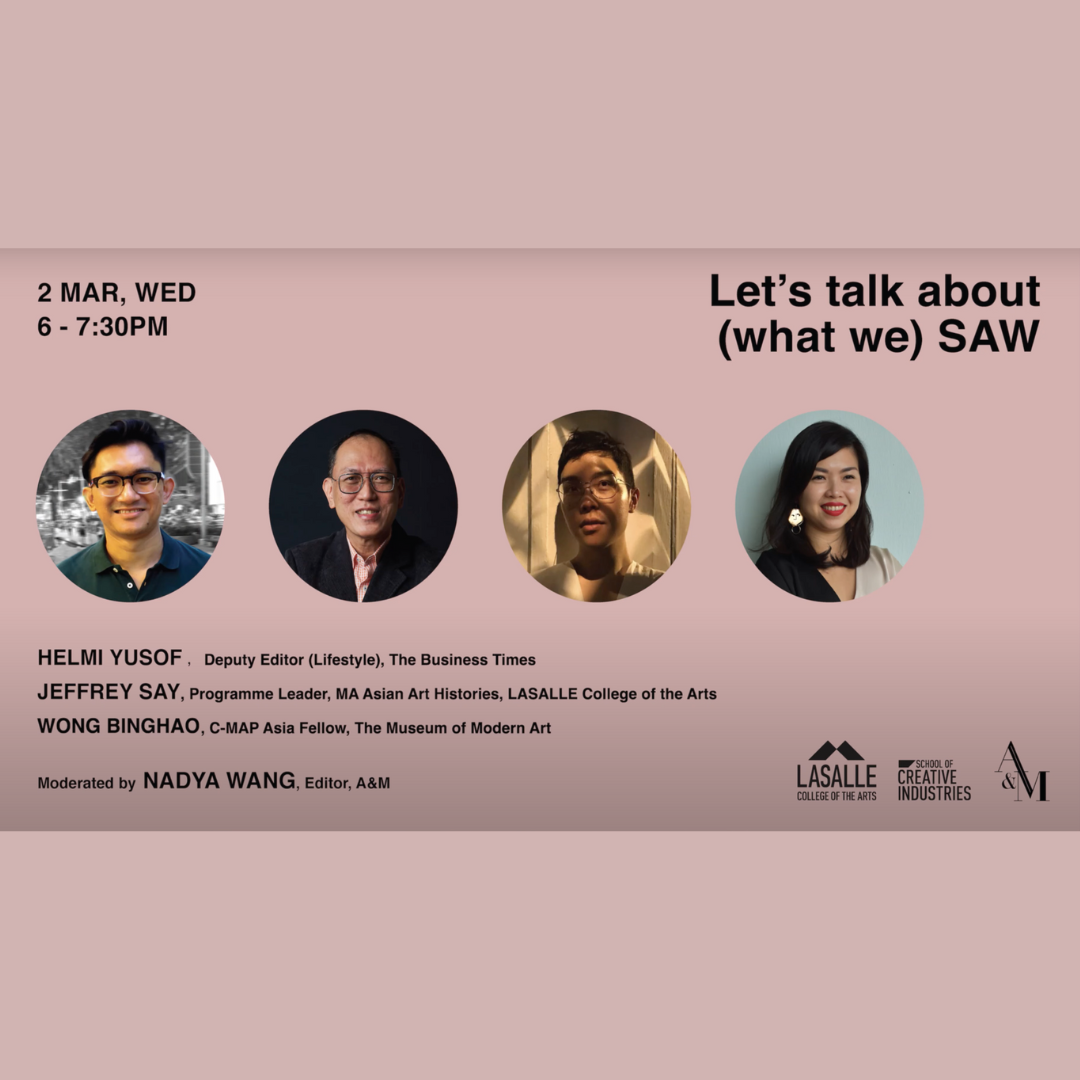My Own Words: Why Do Artists Curate?
Reflecting on ‘We’re Young Once’
By Ian Tee
'My Own Words' is a monthly series which features personal essays by practitioners in the Southeast Asian art community. They deliberate on their locality's present circumstances, articulating observations and challenges in their respective roles.
'We're Young Once', 2022, exhibition view at Art Agenda @ 63 Spottiswoode. Image courtesy of Art Agenda.
In this essay, I aim to unpack my motivations and thought process behind my first curatorial project ‘We’re Young Once’. It is an exhibition with a simple premise: to gather significant works by Singapore artists across generations. In doing so, I explore what it means to be a young artist at different moments in time. What are the interests and contexts reflected in an emerging practitioner’s work?
I had two key criteria for artworks in the show. They need to be representative examples of the artist’s early practice, and speak to the theme of youth in general. This could manifest didactically through representation and symbolism, or more introspectively through the artistic process as well as the philosophical questions they ask about the value of art.
'We're Young Once', 2022, exhibition view at Art Agenda @ 63 Spottiswoode, featuring Tay Ining’s ‘Naked Potato’ (foreground) and Song-Ming Ang’s ‘Justin’ (background). Image courtesy of Art Agenda.
'We're Young Once', 2022, exhibition view at Art Agenda @ 63 Spottiswoode, featuring Teo Eng Seng's 'Emperors Choice' (left) and Shubigi Rao's 'The River of Ink' (right). Image courtesy of Ian Tee.
Provenance is an important consideration in my selection process and each piece points to a significant milestone in the respective artist’s career. There are a number of “student works” on view, such as ‘405012008’ (2008) which Ruben Pang painted while he was studying in LASALLE College of the Arts. Anthony Poon’s ‘Kite’ marquettes (1969-1971) and Tang Da Wu’s ‘Useless Things’ (1971) were made by the artists during their time studying in the United Kingdom. Exhibition history is another marker. Guo Liang Tan’s flower paintings (2008-09), Lai Yu Tong’s ‘Newspaper Paintings’ (2018-) and my Target Painting ‘未成年’ (2019) were from bodies of work presented at first solo exhibitions.
‘We’re Young Once’ has a curatorial framework which allows me to assemble artists who might never be exhibited next to each other, and create unexpected juxtapositions. One example is the pairing of Teo Eng Seng’s paperdyesculpt painting ‘Emperor’s Choice’ (1981) and Shubigi Rao’s ‘The River of Ink’ (2008). While Teo looks at the material potential of pulp, Rao is more interested in pulp as a verb rather than a noun. Despite their different interests and approaches, an unexpected takeaway I had from experiencing their works together is an appreciation for the effect of time on paper. In ‘Emperor’s Choice’, one observes a natural aging of the paperdyesculpt and canvas support, that accentuates the tactile presence of Rao’s handmade books.
Lim Yew Kuan explaining details of his painting ‘War and Peace’ to a visiting curator from Fukuoka Asian Art Museum, 2001. Image courtesy of Koh Nguang How.
Visiting Japanese artists and art personnel at Amanda Heng's studio space at The Artists Village, Lorong Gambas, 1989. Image courtesy of Koh Nguang How.
During the research process, I was conscious that two key Singapore artist groups must be represented in the exhibition: Equator Art Society (EAS) and The Artist Village (TAV). In my eyes, they address the subject of youth head on as two art movements spurred by youthful energy. EAS directed this energy to the championing of social realism which reflected their values and politics during the Malayan Emergency, while TAV and their spirit of experimentation pushed the boundaries of what art can be in Singapore. To locate these historical contexts, the artworks included in ‘We’re Young Once’ should be by artists associated with these movements, and made during the peak of their activity.
“It is fitting for ‘We’re Young Once’ that the re-surfacing of these two artworks is supported by the efforts of another artist.”
Here, I wish to express my gratitude to the artist-archivist Koh Nguang How who aided this search. Lim Yew Kuan’s ‘War and Peace’ (1957) and Amanda Heng’s ‘Lost’ (1989) are two historically significant paintings which have not been exhibited before and are absent in publications on the artists. They came to my attention as I looked through Koh’s extensive archive. It is fitting for ‘We’re Young Once’ that the re-surfacing of these two artworks is supported by the efforts of another artist. Lastly, I would also like to thank the Lim family and Amanda for their openness and trust.
'We're Young Once', 2022, exhibition view at Art Agenda @ 63 Spottiswoode. Image courtesy of Art Agenda.
'We're Young Once', 2022, exhibition view at Art Agenda @ 63 Spottiswoode, featuring Tang Da Wu’s ‘Useless Things’ (foreground) and Lai Yu Tong’s ‘Newspaper Paintings’ (background). Image courtesy of Ian Tee.
“ I believe in the necessity of sharing these origin stories because they demystify the artistic process and give context to the journey each artist has to take.”
Youths In Balaclava, detail shot of ‘Twisted Paradise’, 2022. Image courtesy of Art Agenda.
'We're Young Once' T-Shirt by YIB Bandits (front). Image courtesy of YIB Bandits.
'We're Young Once' T-Shirt by YIB Bandits (back), featuring the list of exhibiting artists. Image courtesy of YIB Bandits.
To end this essay on a lighter note, I wish to mention our collaboration with Youths In Balaclava (YIB), a Singaporean design collective and streetwear brand. Their inclusion in the exhibition line up may seem like a wildcard, but I appreciate the sense of aspiration which the collective represents. In organising a show about youth, I am also challenged to give form to something as intangible as energy and vitality. On this front, working with YIB has opened up a new avenue to explore the types of gestures that can be made in an exhibitionary context.
Personally, I love a good museum shop and thoughtful exhibition merchandise so it is a blessing to be able to collaborate with YIB on the ‘We’re Young Once’ T-shirt. They were given free rein on the t-shirt design and liberty to play with the exhibition logo. The fact that these t-shirts are hand-silkscreened on blanks that carry the YIB Bandits label is particularly meaningful for me. This is because it signifies an aesthetic and financial co-ownership of the product. It is important that monetary gain is distributed fairly between partners, rather than having the production outsourced to a third party. On another level, this DIY ethos captures the spirit of the show and gives the object integrity. It feels like an appropriate place to end ‘We’re Young Once’ and mark another specific moment in time.
The views and opinions expressed in this article are the author's own and do not necessarily reflect those of A&M.
‘We’re Young Once’ is on view at Art Agenda @ 63 Spottiswoode, from 8 to 30 January 2022.
Pre-order the ‘We’re Young Once’ t-shirt created by YIB Bandits before 30 January 2022. It is exclusively available on A&M Marketplace.
Read all My Own Words essays here.























